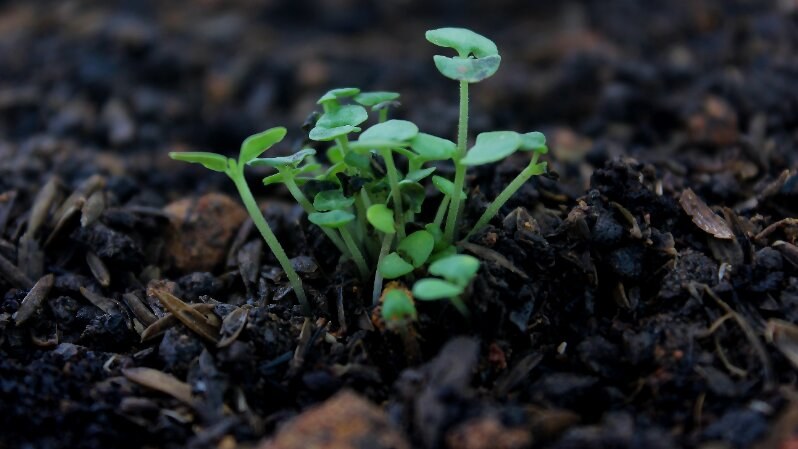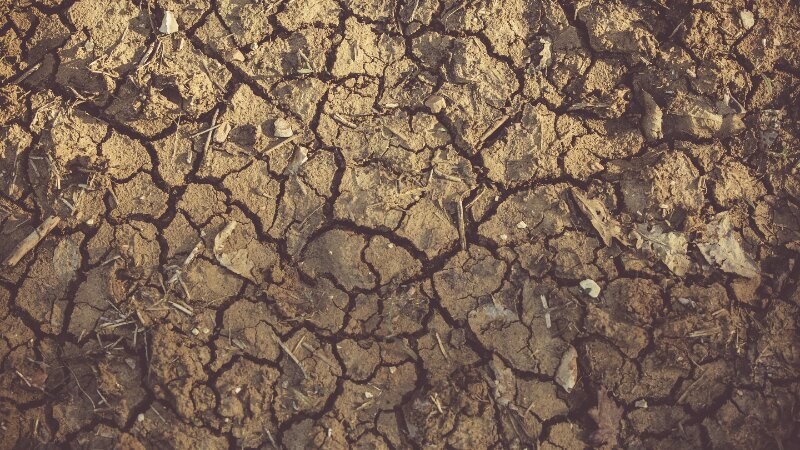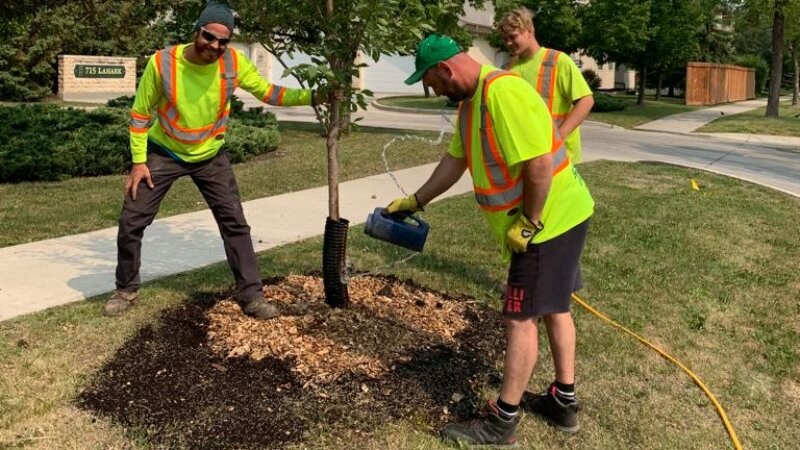How to Maintain Healthy Soil for Your Trees on Your Own
Reading time: 7 minutesThe quality of your trees is a reflection of the quality of your soil and vice versa. So, if your trees are in rough shape, it’s a good indicator of a problem with your soil. And if your soil is in poor condition, it’s only a matter of time before it impacts your trees.
As arborists, we know what it takes to grow tall, lush trees that are free of disease – and that means starting with healthy soil. Here’s what to know and where you can learn more about quality tree and lawn care from our qualified specialists.

Benefits of Healthy Soil for Your Trees
The University of Saskatchewan emphasizes the importance of soil preservation in Canada since the area's soils are relatively young and still rich in organic matter and beneficial nutrients. According to Canadian Food Focus, healthy soil also helps to regulate water supply and filter stormwater, which promotes strong root systems. Soil conservation has become so integral to the ecosystem that the number of published studies about soil health rose by nearly 850% between 2006 and 2018 alone.
Quality soil provides tree roots with adequate drainage and prevents them from becoming waterlogged while still holding enough moisture to prevent drought. This allows roots to grow easily through the soil and quickly access pockets of water and nutrients, which can't be done when soil is wet and compacted.
Here are some characteristics of healthy soil:
- Light, crumbly texture
- Neither too dry nor too wet
- Moist to the touch
- Dark brown
- Earthy scent
Testing Your Soil
Whether you suspect a problem with your soil or not, it's always a good idea to test it. This gives you an idea of what you're working with so you know which nutrients need to be added. Soil test kits are readily available online and in most garden supply centres and are easy to use.
Most trees grow well in soil with a neutral or slightly acidic pH level. However, the Government of Canada reports that Alberta and British Columbia tend to have much more acidic soil, which can be challenging for homeowners taking care of their lawns and trees.
In practice, it's difficult to change the pH significantly, and it tends to revert back over time. For instance, in Winnipeg, where the soil is very alkaline, adjusting soil pH can be quite challenging. This is particularly relevant for tree species like Silver Maple, which struggle to acquire sufficient iron in alkaline conditions.
We typically address this with direct iron treatments, such as sprays or soil injections, rather than attempting to amend the soil pH. This subject is a bit tricky, so if you can get a professional on board, even better!
Signs Your Soil Is Unhealthy
It can sometimes be difficult to tell if there are problems with your soil. However, these are some clear signs that some adjustments need to be made:
- When soil is watered, only the top layer is saturated; the underneath stays compacted and dry.
- Nothing is growing in your soil, or your trees are beginning to look stunted or bare.
- There are no beneficial insects like spiders, worms, beetles, and other insects that help aerate the soil when you dig down into the ground.
- Your soil is dry and crumbly or very wet and sticky.
- Your soil smells like sulphur or rotten eggs, which is a key sign of insufficient drainage.
How to Avoid Soil Degradation
Soil degradation occurs when the quality of an area’s soil is reduced. Soil may only be degraded by a small margin, or it may be so depleted of water, oxygen, and minerals that it can no longer sustain plant life. Understanding what contributes to soil deterioration and what you can do to prevent it is far easier and less expensive than rehabilitating your soil after it has depleted.
Here are some key things to avoid if you want to keep your soil in good condition:
- Don’t use synthetic or chemical fertilizers on your trees. Not all lawn fertilizers are created equal, and some contain harmful chemicals or synthetic compounds that can cause more problems than they solve. This also applies to pesticides and weed killers.
- Avoid working with your soil after watering or rain. You could inadvertently harm its structure, causing it to stick together and form a hard, crust-like surface. Allow it to drain well before digging or planting.
- Limit or eliminate the use of synthetic pesticides. Just like with fertilizer, many readily available pesticides are made from hazardous ingredients that could potentially cause damage to your soil. Instead, consider working with a professional to develop a safe and effective long-term pest control strategy that utilizes alternative methods.
- Prevent your soil from becoming compacted. When soil is compressed from the top down, it becomes compacted and difficult for tree roots to break through. Compaction typically occurs when too-wet soil is walked or driven on repeatedly or with heavy loads. You can avoid this by using designated walkways and garden paths, especially in the winter when your lawn is more likely to be waterlogged by snow and ice.

Best Practices to Improve Your Soil
These three best practices can help you maintain good quality soil long-term so that established and newly planted trees on your property remain in excellent condition.
Keep Your Soil Well Aerated
Lawn aeration is critical for keeping your trees healthy and thriving. All plants require oxygen and carbon dioxide from the atmosphere for their metabolism. Trees carry this carbon to their root systems, releasing the gas into the soil. When soil is compacted, this process is inhibited and can risk a tree’s health.
Proper aeration opens up more space within the soil, allowing critical processes like water and nutrient absorption to occur without problems.
Know All About Soil Amendment
The amount of organic matter in your soil is an excellent indicator of how well it’s doing. A good balance of soil and organic matter is ideal, and you can add matter – called amendments – to your soil to improve its quality.
Which soil amendment you should use depends on the current condition of your soil:
- Sandy soil. This soil type is dry and loose, making it difficult to retain nutrients or moisture long enough for trees to absorb them. To improve sandy soil, add manure, worm castings, vermiculite, or compost.
- Clay soil. If your soil is wet, sticky, and dense, try adding straw, compost, shredded leaves and bark, perlite, or peat moss.
- Silty soil. This soil type is wet, slippery, and moves around easily. Roots are unstable in silty soil, and inclement weather can quickly cause erosion. Wood chips, composted manure, or shredded leaves can improve the texture of this kind of soil.
Adjusting soil pH can be tricky, and over time, pH levels can revert back to previous levels if consistent testing and applications are not maintained. So, a great option to address these deficiencies is direct iron treatments, such as sprays or soil injections, rather than attempting to amend the soil pH.
Add a Layer of Organic Mulch
While mulch is technically a soil amendment, it has numerous benefits that deserve their own section. When you mulch around your trees properly, you can preserve the quality of your soil and protect your trees’ root systems.
Mulching:
- Decreases water evaporation. Mulch helps retain moisture and prevents it from evaporating, which is especially important during the summer when trees are prone to drought.
- Shields tree roots. Trees with a layer of mulch over their roots are protected from harsh wind, snow, ice, and physical damage by lawnmowers and weed eaters. Mulch also protects tree roots from temperature changes in the winter, which is critical in Western Canada's bitterly cold climate.
- Reduces erosion. If you have silty soil or your trees are in an area of your yard prone to soil erosion, mulching around your trees is key to preventing the roots from becoming exposed to soil loss.
- Prevents weeds. Most weeds can’t push through mulch, especially when it’s made from larger bark pieces.

Protect Your Soil All Year Long with Green Drop
How well you take care of your soil directly affects how well your trees and lawn grow and thrive throughout the year. That’s why our ISA-certified arborists have perfected the process of caring for trees from leaf to root and beyond, using our RootBoost™️ (Deep Root Fertilization) technology.
We’re based in Calgary, Edmonton, Red Deer, Regina, Saskatoon and Winnipeg.

